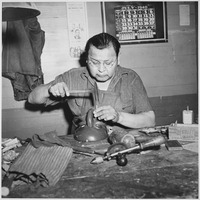Jesse Cornplanter
| Jesse Cornplanter | |
|---|---|

Jesse Cornplanter making a ceremonial mask, Tonawanda Community House, Tonawanda, New York. Photographed in 1940.
|
|
| Born | Hayonhwonhish September 16, 1889 Cattaraugus Reservation, NY United States |
| Died | 1957 Genesee, NY |
| Occupation | Author, artist, craftsman |
| Ethnicity | Iroquois |
| Citizenship | American citizen 1924 |
| Subject | Seneca life, culture, and religion |
| Literary movement | Iroquois Realism |
| Notable works | Legends of the Longhouse, Iroquois Indian Games and Dances, collection SC12845 at the New York State Library, illustrated The Code of Handsome Lake |
| Relatives | Father Edward Cornplanter (Seneca name Sosondowah) |
Jesse J. Cornplanter (September 16, 1889 – 1957) (Seneca) was an artist and author. The last descendant of Cornplanter, an important 18th-century leader, his Seneca name was Hayonhwonhish. He illustrated several books about Seneca and Iroquois life. Jesse Cornplanter wrote and illustrated Legends of the Longhouse (1938), which records many Iroquois traditional stories.
Jesse Cornplanter was born in 1889 to Seneca parents Nancy Jack and Edward Cornplanter on the Cattaraugus Reservation in New York. He had two sisters. He was the last male direct descendant of Cornplanter, a renowned Seneca war chief during and after the American Revolutionary War.
During World War I, Cornplanter enlisted in the US Army in 1917 and served in Europe. He was wounded during the war and received the Purple Heart. While he was serving in the war, his father died. This was followed by the deaths of most of his remaining family in the 1918 flu pandemic, including his parents, a sister, and nieces and nephews. One sister and two orphaned children of his late sister survived. Cornplanter helped support and rear the children.
After the war, Cornplanter held many respected positions within his tribe. These included the ceremonial chief of the Long House and the chief of New Town, a traditional village. He sang for the Great Feather Dancer and was head singer for many ceremonies. He never married or fathered any known children.
Because Jesse Cornplanter left no heirs, his death in 1957 marked the official expiration of a treaty granting Cornplanter's heirs a perpetual Pennsylvania land grant of about 1500 acres along the Allegheny River. Following construction of Kinzua Dam by the US Army Corps of Engineers, completed in 1965, much of the former Cornplanter tract was flooded as a result of creation of a reservoir behind the dam for flood control and hydropower. This was in addition to 10,000 acres the COE took from the Seneca Nation of its lands along the river in New York.
...
Wikipedia
